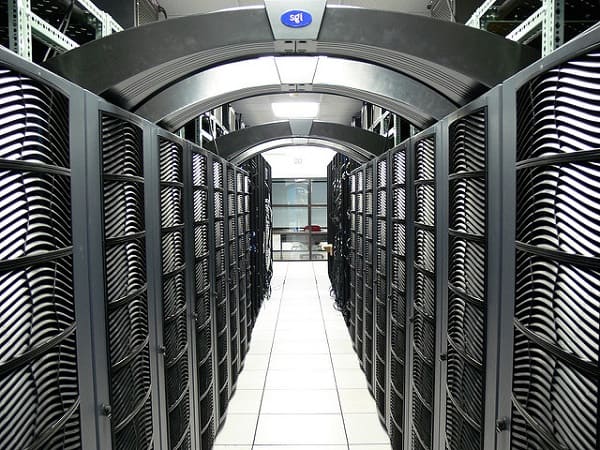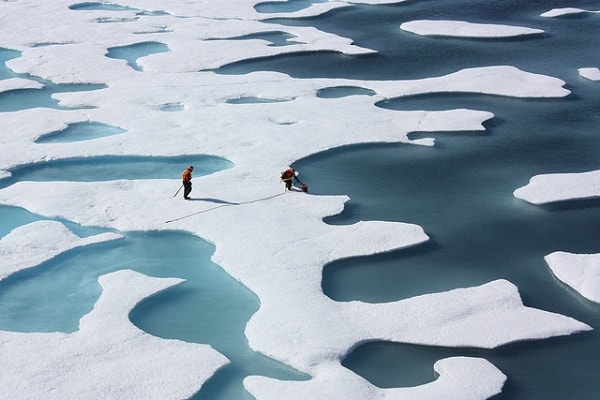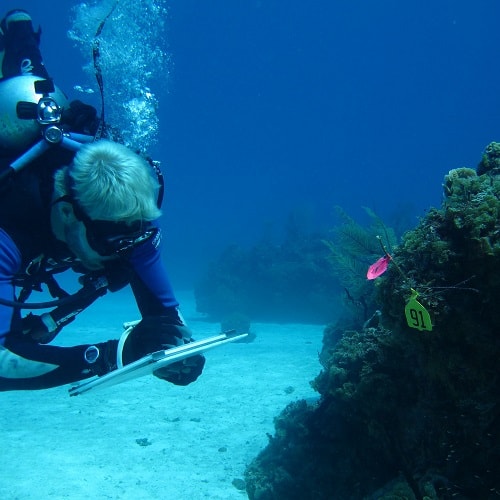My goal is to skirt gingerly around evidence leaving it just where it lies, and instead to prod the contingent margins where iterative social practices and their artifacts are in the process of becoming available as evidence. In what follows, I explore a site where evidentiary practices are configured through efforts to create and maintain a catalog of scientific geospatial data sets, web services, and data tools pertaining to the eastern Pacific Ocean, lying within the jurisdictions of the U.S., California, Oregon, Washington, and various Native North American tribal governments. Scientific geospatial work gathers and organizes numerous discrete bits of information, each recorded with its own specific time, location and other attributes, into visual tools, such as tables, maps, atlases, which model, for example and among other things, commercial fishing catch sizes and compositions landed along the Pacific coast, the numbers and sizes of ships passing through a shipping lane at given points in time, and the amounts of different kinds of trash collected on hundreds of different beaches on given days. The gestalts produced by the tables and maps give rise to new questions and make visible hitherto unseen conditions and connections. This technical approach to picturing and understanding the oceans has grown hand-in-hand with the development of more comprehensive approaches by governments to managing oceans, especially the creation and implementation of ecosystem-based marine spatial planning and zoning.

Since late 2013, I have been studying the efforts of a group of people, composed largely of geospatial experts from government agencies and government-supported science entities, as they create and maintain a regional data network, including an online catalog which harvests and then provides access to numerous ocean observation data sets and web services. This portal provides links to existing data sets, web services, tools, and other catalogs, which are in turn housed by their various producers, who likely produce, maintain, manage, and house not one but many such data sets and end-products. The aim of the portal builders, in this specific capacity, is not to create data sets, nor to collect data, nor to house data, but rather to make existing data sets discoverable and accessible, and to network data providers. Initially, they focused on bringing data providers and data tool makers into the network, along with links to their materials in order to create the catalog. As the catalog has become established, their focus is expanding to better include data users. The portal effort has been supported by limited funds from various government agencies, private foundations, and contributions of volunteered time and expertise by portal builders. Federal level efforts to create open access to federally funded scientific research, coupled with the U.S. Oceans Act 2000, the formation of Regional Ocean Partnerships, Executive Order 13547 (Stewardship of the Oceans, Our Coasts and the Great Lakes 2010), the National Ocean Policy Implementation Plan (National Ocean Council) 2013, have fostered both data sharing practices and ocean conservation efforts, which in turn rely on some kind of networking of data resources, data providers, and data users.
Evidence and oceans have much in common. They are easy to see in their particularity, but their knowledge forms resist legibility, and thus evidence and oceans demand more oblique approaches to making them visible.
By definition, evidence is categorical and particular, although often only ideally so (Engelke 2008:S4-S5). Evidentiary practices produce and reproduce evidence according to rules, or at the very least, protocols, while the material boundaries of the abstract category ‘evidence’ are determined by purpose and disciplinary context (Kandel 1992; Rigby and Sevareid 1992; Hastrup 2004; Engelke 2008; Good 2008). Given that oceans too can be difficult to ‘see’ below their surfaces, and that ‘seeing’ requires a high level of expertise, often gleaned through years of practical experience in sea-based activities, the products of geospatial technologies have been a real eye opener for people whose expertise lies not in practical sea-based trades, but in understanding and predicting the ocean’s behaviors and conditions in order to manage various and often competing uses of the ocean.
Significantly, geospatial data, like evidence, leave us to wonder at the kinds of influential and shaping cultural logics that underpin their final forms, and which contribute to their status as proof of particular conditions.
Over the last several decades, the legibility of ocean resources has become increasingly important and increasingly the focus of technological innovation, especially as the impending effects of ocean warming, ocean acidification, increased competition among users of oceans, and sea level rise press governments toward more proactively planning for the futures of their constituencies. Numerous entities, including universities, NGOs and government agencies have worked to make ocean surveillance more effective, by systematically accumulating and organizing large collections of temporally and spatially sensitive observational data. However, the many quotidian decisions and their logics that make oceans visible cannot be pinned to a specific group’s actions, nor to a few technologies, because knowledge sharing and knowledge production are built on an expanding repertoire of transportable and transformable knowledge forms. Geospatial data sets, maps, models, web services, and tools are the products of many hands, eyes, minds, ideas and technologies, and they remain malleable even once catalogued, ready to be recombined into new products in open-ended rhizomatic practices of knowledge fashioning.

Evidentiary practices in the social site of the portal are not confined to a single register, but of necessity operate in several registers at once, each register producing its own effects, which are connected to each other but which cannot be reduced to each other.
To become part of the catalog, data sets and tools must meet portal evidentiary criteria and standards, while the portal itself must provide evidence of its worth as source for finding reliable evidence about ocean conditions. Portal builders see their work, as well as their catalog, as instituted by and responding to policy needs, which they themselves do not delineate, and which they are studiously careful to avoid defining and/or creating, as that would be to overstep their place in the hierarchical system of defining policy and making policy decisions. They are keenly aware that the future of the portal depends on demonstrating the worth of the portal to policy makers, management decision-makers, and funders, which include government agencies.
The portal catalog is built on the notion of ‘best available science,’ a notion now widely circulating in ocean governance circles, but only recently so in so ubiquitous a manner. The notion of ‘best available science,’ now ensconced in and promulgated through laws and policy documents [Note 1], has its own interesting history, which is much too long to cover in my short discussion here. The notion is often invoked to assert the idea that government should use the best science available at the time to make decisions, because decisions have to be made, and we cannot wait until all of the science is known, there will always be knowledge gaps, and what we know is always changing. The terms ‘best’ (which can refer to most up-to-date, most comprehensive, most authoritative, peer-reviewed, etc.) and ‘science’ are terms entangled with, more immediately, the history of the emergence of the notion of ‘best available science’ in U.S. governance circles, and in a broader sense, entangled with the history of what Poovey refers to as “the epistemic unit” that she calls “the modern fact” (1998). However we bracket ‘best’ and ‘science’ for now, ‘availability’ is exactly the piece of that notion, ‘best available science,’ that portal builders are tasked with defining and making operable, by various policy assemblies and funders.

This interdependence of providing evidence in several concurrent registers creates a situation in which there is an impetus toward creative problem solving directed at creating ‘availability,’ even as this rhizomatic inclination is not free of constraints.
Over time, the portal builders, who once explicitly focused on harvesting and cataloging, have expanded their efforts by creating a few of their own geospatial products, which freshly synthesize data sets and web services available through the portal catalog, and which, in turn, provide both new information about the ocean, as well as evidence of the portal’s worth. Evidentiary practices in bureaucratic undertakings police the boundaries of what counts as authoritative knowledge, and as Mathew Hull (2003) suggests, also police present practices in anticipation of uncertain future conditions. The uncertain futurity of both ocean conditions and political configurations within the many participating governments and agencies helps foster the emergent aspects of portal creation, especially as the catalog’s contents are assembled in order to address the policy priorities of the policy assemblies directing the portal builders and drawing on the portal.
Theoretically astute approaches (Sedgwick 1994; Poovey 1998; Daston 1994, 2005; Strathern 2008) aiming to illuminate the epistemes informing both the context of and evidentiary practices themselves, are a promising starting point for investigating the emergent cultural logics operating in oceanic knowledge production sites. Daston (2005) argues that efforts to establish scientific authority from the 1500s onward are accompanied by an increasing certainty that error lurks everywhere and that the job of science is to root out, expose and correct error through epistemology. I would argue that the link between error and epistemology that Daston (2005) posits evinces a fresh iteration in the currents of ocean governance practices. This iteration is not an effort to avoid error but rather one of embracing error, flipping the orientations toward error that Daston outlines onto their heads, without abandoning a concern to correct errors and to expose and fill gaps in what is known.
The notion of ‘best available science’ embraces error as a necessary condition of scientific knowledge, and thus frees scientific knowledge from the need, and indeed even the possibility of ever being fixed, final, or complete.
The notion of ‘best available science’ is closely tied to the notion of ‘adaptive’ management, i.e., a willingness to change management practices in light of new scientific knowledge. ‘Adaptive’ management is ensconced alongside ‘best available science’ in the same laws and policy documents. These intertwined notions of ‘best available science’ and ‘adaptive’ management work together to situate governance practices (like scientific knowledge) as open-ended, reflexive, and responsive to changing policy needs and priorities.

Fisher points out, “emergent forms of life” are sites of contestation saturated with “the continual negotiation of historical and emergent modalities of ethical and political reason” (2005:56). Certainly the generation and, equally significantly, the availability of numerous large data sets that can be used alone or in ever changing combinations constitutes one such site of emergent social life.
Making these data sets discoverable and accessible, and thus open to recombination relies on a network of human beings, a point that the portal builders have expressly emphasized and fostered in the creation of their data network.
This human network is in turn subject to numerous social tensions that have to be negotiated, including finding funding, implementing data standards, and to paraphrase one person, grappling with the persistent invisibility of IT (information technology) to everyone else, especially when the technological interfaces are functioning smoothly.
[Note 1] In California, the approach of combining ‘best available science’ with ‘adaptive’ management was stipulated in the Marine Life Protection Act of 1999 (Fish and Game Code chapters 2850-2863), reinforced in supporting policy documents, and frames the comprehensive (eco-system based and cooperation among agencies) marine spatial planning effort that established the now operative California network of marine protected areas. The U.S. Oceans Act 2000, and subsequently Executive Order 13547, also embrace this approach for all U.S. oceans, and also concern the fostering of marine spatial planning and integrated inter-agency cooperation.
References:
Daston, Lorraine
1994[1991] Marvelous Facts and Miraculous Evidence in Early Modern Europe. In James Chandler, Arnold I. Davidson, and Harry Harootunian (eds.) Questions of Evidence: Proof, Practice, and Persuasion across the Disciplines. Pp. 243-274.The University of Chicago Press.
Daston, Lorraine
2005 Scientific Error and the Ethos of Belief. Social Research 72(1):1-28.
Engelke, Mathew
2008 The Objects of Evidence. In Mathew Engelke (ed.) Special Issue: The Objects of Evidence: Anthropological Approaches to the Production of Knowledge. The Journal of the Royal Anthropological Institute (N.S.) Vol. 14: S1-S21.
Fisher, Michael
2005 Technoscientific Infrastructures and Emergent Forms of Life: A Commentary. American Anthropologist 107(1):55-61.
Good, Anthony
2008 Cultural Evidence in Courts of Law. In Mathew Engelke (ed.) Special Issue: The Objects of Evidence: Anthropological Approaches to the Production of Knowledge. The Journal of the Royal Anthropological Institute (N.S.) Vol. 14:S47-S60.
Hastrup, Kirsten
2004 Getting it Right: Knowledge and Evidence in Anthropology. Anthropological Theory 4(4):455-472.
Hull, Mathew S.
2003 The File: Agency, Authority, and Autography in an Islamabad Bureaucracy. Language and Communication 23:287-314.
Kandel, Randy, Francis
1992 Six Differences in Assumptions and Outlook between Anthropologists and Attorneys. In Randy Frances Kandel (ed.) Double Vision: Anthropologists at Law. Pp. 1-4. NAPA Bulletin 11. National Association for Practice of Anthropology, American Anthropological Association.
Poovey, Mary
1998 A History of the Modern Fact: Problems of Knowledge in the Sciences of Wealth and Society. The University of Chicago Press.
Rigby, Peter, and Peter Sevareid
1992 Lawyers, Anthropologists and the Knowledge of Facts. In Randy Frances Kandel (ed.) Double Vision: Anthropologists at Law. Pp. 5-21. NAPA Bulletin 11. National Association for Practice of Anthropology, American Anthropological Association.
Sedgwick, Eve Kosofsky
1994[1991] Jane Austin and the Masturbating Girl. In James Chandler, Arnold I. Davidson, and Harry Harootunian (eds.) Questions of Evidence: Proof, Practice, and Persuasion across the Disciplines. Pp. 105-124.The University of Chicago Press.
Strathern, Marilyn
2008 Old and New Reflections. In Liana Chua, Casey High, and Timm Lau (eds.) How Do We Know? Evidence, Ethnography, and the Making of Anthropological Knowledge. Pp. 20-35. Cambridge Scholars Publishing.
Featured image by Oregon State University (flickr, CC BY-SA 2.0).





